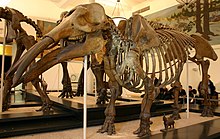Gomphothere
| Gomphothere Temporal range: 12–0.006 Ma Miocene - Holocene |
|
|---|---|
 |
|
| Specimen of Gomphotherium productum at the AMNH | |
| Scientific classification | |
| Kingdom: | Animalia |
| Phylum: | Chordata |
| Clade: | Synapsida |
| Class: | Mammalia |
| Order: | Proboscidea |
| Superfamily: | †Gomphotherioidea |
| Family: |
†Gomphotheriidae (Hay, 1922) A. Cabrera 1929 |
| Genera | |
|
|
Gomphotheres are any members of the diverse, extinct taxonomic family Gomphotheriidae. Gomphotheres were superficially elephant-like proboscideans. They were widespread in North America during the Miocene and Pliocene epochs, 12–1.6 million years ago. Some lived in parts of Eurasia, Beringia, and following the Great American Interchange, South America. Beginning about 5 million years ago, they were gradually replaced by modern elephants, apart from the last two South American genera, of which Cuvieronius did not become extinct until possibly as recently as 9,100 BP, and Stegomastodon fossils have been dated to as recently as 6,060 BP in the Valle del Magdalena, Colombia. These gomphotheres also survived in Mexico and Central America until the end of the .
The name "gomphothere" comes from Ancient Greek γόμφος, "peg, pin; wedge; joint" plus θηρίον, "beast".
Gomphotheres differed from elephants in their tooth structure, particularly the chewing surfaces on the molar teeth. Most had four tusks, and their retracted facial and nasal bones prompt paleontologists to believe that gomphotheres had elephant-like trunks.
Both the genus Gomphotherium and family Gomphotheriidae were erected by the German zoologist Karl Hermann Konrad Burmeister (1807-1892) in 1837.
...
Wikipedia
